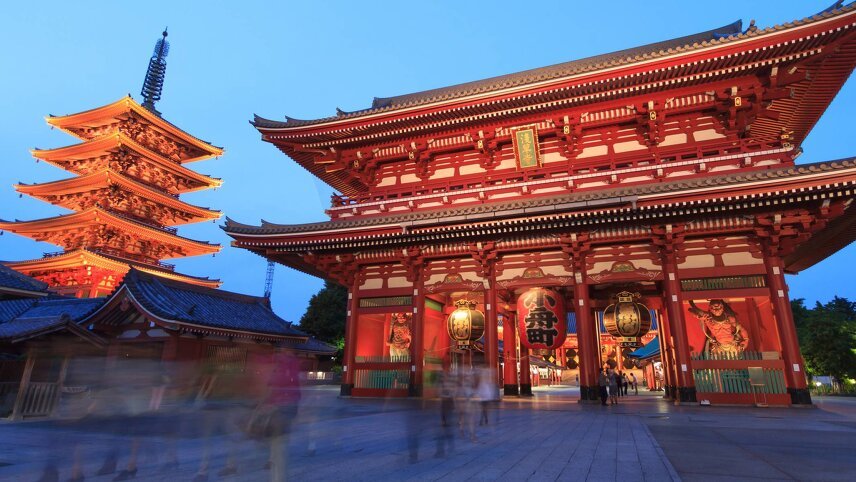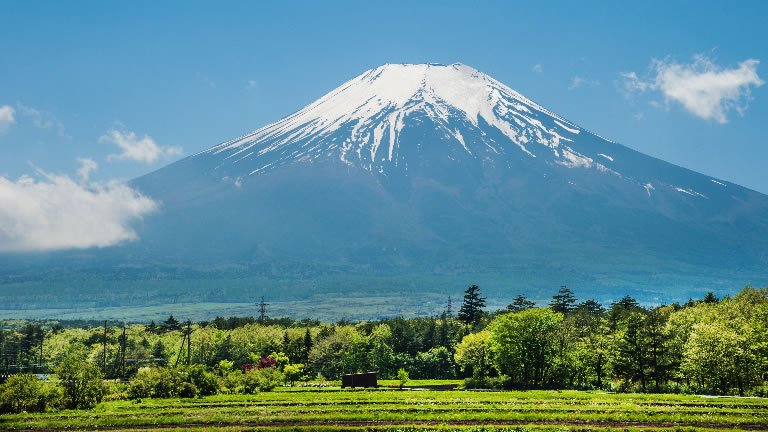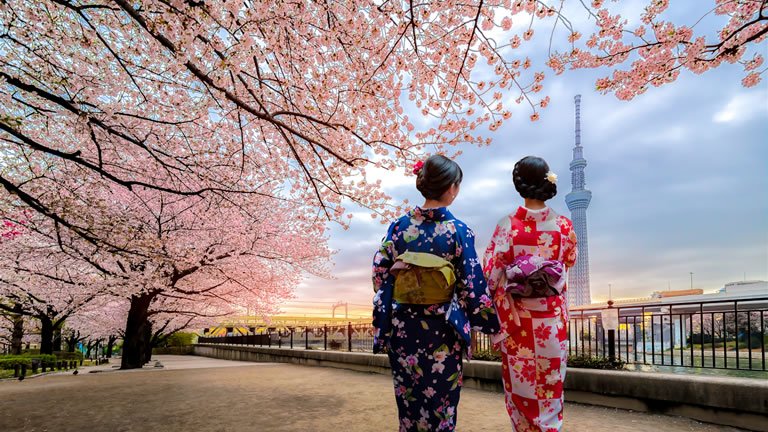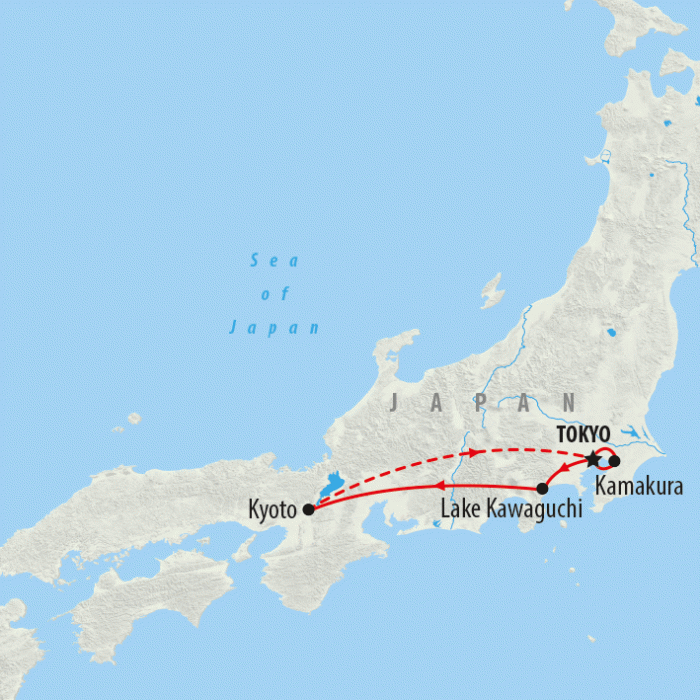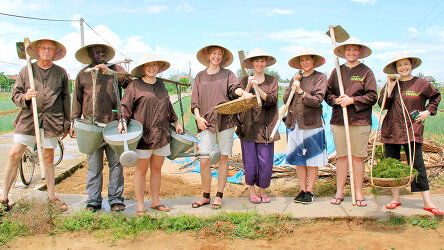Overview
Itinerary
Upon arrival to Tokyo you will be met at either Narita or Haneda International Airport by your guide. Travel by train into the heart of the city and check into your hotel. The rest of the day is free to spend at your leisure.
We recommend arriving before 3pm on this day, as there will be a Welcome Meeting at 6pm, where you will meet your guide and the rest of the group.
Today we explore the capital. Taking the subway to Asakusa we visit the lively Sensoji Temple District, which is home to Tokyo's first temple and scores of interesting souvenir and craft stalls.
In the afternoon we'll head to Harajuku, which is a magnet for young and fashionable Tokyoites with its hip shops and cafes. Here, we'll visit the impressive Meiji Shrine where the emperor Meiji and his wife are enshrined. Yoyogi Park, beside the shrine is a popular hangout for locals and there is always a lot going on, especially on Sundays with bands playing, drum circles, dancers and busking.
The last stop of the day is Shibuya Crossing - regarded as one of the busiest intersections in the world. The famed junction has no less than 7 pedestrian crossings and when the traffic lights turn red a wave of pedestrians, up to a 1000, converge onto the intersection from every direction. Known as 'the scramble', it's a well-practised art to duck and weave with sportsman like agility to avoid collision, which we'll watch from the second floor of Starbucks, located directly opposite the crossing.
This evening offers free time, though if travelling in January, May and September you might like spend the evening watching a Sumo tournament (must be booked in advance). See our Trip Notes for more information.
This morning we board a train for our day trip to Kamakura, Japan's first feudal capital, which is just an hour from Tokyo. Kamakura is a popular seaside location with a quaint village life feel and some stunning Zen temples. Here we'll visit the iconic bronze Big Buddha and the Zen Temple of Hokokuji with its beautiful bamboo garden. Here, you can drink tea and learn about the tea ceremony before walking the cobbled shopping district - adorned with lovely locally made items before returning to Japan's bustling capital for the night.
Tonight, we'll organise a Shabu Shabu (a traditional Japanese hot pot meal) if the majority of the group are interested.
Today offers a guided tour of the Tokyo National Museum, housing a number of exhibitions from galleries to Japanese archeology. The Tokyo National Museum is located in Ueno Park, a large public park within central Tokyo and famous for a number of museums held within it's grounds. The remainder of the day offers free time to independently explore.
This morning we travel by highway bus (with luggage forwarding) to Lake Kawaguchi, located at the foot of Mt Fuji in the Fuji Hakone Izu National Park. The scenery is stunning with panoramic views of a snow-capped Fuji most of the year.
Upon arrival we'll travel along the Mount Fuji Panoramic Ropeway and visit the observatory. For tours staying at Lake Kawaguchi between 15 Apr – 28 May each year we'll visit the Springtime Fuji Shibazakura (Phlox Moss) Festival held at Motosu Lake, where the landscape is covered in a vibrant, hot pink moss with Fuji as the backdrop. No trip to Japan would be complete without sampling authentic Japanese hospitality at a traditional ryokan (a Japanese inn), which is where we'll bed down tonight. At the ryokan, sample tasty local cuisine and take a relaxing dip in the natural hot spring baths. (D)
The area has some great hiking trails and early this morning you might like to opt for a hike along the foreshores of the lake. We then travel by bus to Mishima, then bullet train to Kyoto - Japan's ancient and cultural capital.
As one of the most culturally rich cities in Asia, Kyoto is home to an abundance of UNESCO World Heritage Sites, Buddhist temples and Shinto shrines. Here we enjoy a guided tour of Sanjusagen-do Temple, famous for its statues of Kannon, the goddess of mercy. The one thousand life-size statues of Kannon are made of Japanese cypress clad in gold leaf. They stand in 10 rows of 50, each hand crafted and slightly different from the next.
Late this afternoon we head to Gion, for a walking tour of this famous Geisha District. After, you may wish to watch a cultural performance at Gion Corner Theatre where you'll have the opportunity to see a Maiko (apprentice Geisha) performing. (B)
This morning, we enjoy a guided tour of Nijo Castle, one of the city's most impressive UNESCO sites. Built by the first Tokugawa shogun in 1603, the exquisite Nijo Castle is a wonderful example of Momoyama architecture. After, we visit Kinkakuji (Golden Pavilion) a stunning Zen Buddhist temple and part of the Historic Monuments of Ancient Kyoto World Heritage Site. The top two floors of the monument are completely covered in gold leaf. Set upon a small lake with landscaped gardens, the large completely gilt structure is impressive, as it is a beautiful Temple. Kinkakuji Temple continues to be one of Japan's most visited temples.
This afternoon offers free time for you to relax or to further discover the many sights of Kyoto your own way. Consider visiting Fushimi Inari Shrine, famous for its winding path lined by thousands of bright red torii gates. Just a short train ride away from the main Kyoto Station, this must-see sight is free to visit and is open 24 hours a day. You might also wish to hire a Kimono and walk the streets as many Japanese do or take part in a cooking lesson. (B)
Our tour comes to an end after hotel check out. (B)
Trip Inclusions
- Tokyo - Explore the Sensoji Temple district and temple, Harajuku, Takeshita Street, Meiji Shrine and Shibuya Crossing
- Kamakura - Visit the Big Buddha Statue, Hokokuji Zen Temple and the Bamboo Forest with a delightful village atmosphere. Opt to take part in a traditional tea ceremony
- Lake Kawaguchi in Fuji Hakone Izu National Park - Marvel at the spectacular mountain scenery and views of Mt Fuji
- Ryokan - Sample Japanese hospitality, bathe in natural hot springs, wearing a Yukata (casual Kimono) and sleeping on a futon
- Kyoto - Explore this UNESCO Listed Nijo Castle, Sanjusagen-do Temple with its 1000 life-like statues and Kinkakuji Temple (Golden Temple)
- Kyoto - Take part in a walking tour of the famed Geisha District (Gion), with its ancient cobbled streets, streams, bridges and quaint teahouses and the opportunity to see Geisha and Maiko en route to their next engagement
- 3 breakfasts and 1 Japanese dinner at the Lake Kawaguchi
- Guided sightseeing and walking tours in Tokyo, Kamakura, Lake Kawaguchi and Kyoto
- Lake Kawaguchi and Mt Fuji - Kachikachi-yama Ropeway and observatory. For tours staying at Lake Kawaguchi between 14 Apr – 28 May each year we'll visit to the Fuji Shibazakura (Moss Phlox) Festival with Mt Fuji as the backdrop
- Escorted by a licensed English speaking Japanese tour guide
- All transportation and transfers - buses, trains and bullet trains including Suica swipe card
- Baggage forwarding service from Tokyo to Kyoto (one bag per person)
- Airport arrival transfer to tour hotel (by train) from Narita or Haneda International Airport on day 1
- Maximum Group size: 18 persons
- 7 nights 3 star (inclusive of 1 night in a traditional Japanese Inn)
- Yaesu Terminal Hotel (Tokyo)
- Yamagishi Ryokan (Lake Kawaguchi)
- Hotel Mifujien (Lake Kawaguchi)
- Dormy Inn Premium Kyoto (Kyoto)
- Hotel Elcient Kyoto (Kyoto)
- Sanco Inn Kyoto Hachijoguchi Shikinoyu (Kyoto)
- Excludes Airport departure transfer
- Excludes International flights and visa
- Excludes If you are opting to pay the single supplement, allowing you the privacy of your own room on this tour, a single room will be provided for all nights with the exception of day 5 (at Lake Kawaguchi), where single rooms are not available. For this night you will be matched up with a fellow tour member of the same gender
- Excludes Tip for your tour guide. We recommend you allow USD$3-5 per day, per traveller. Tipping your guide is an entirely personal gesture
- Excludes Entrance Fees: USD$25-35pp, paid locally in local currency
Brochure

On The Go Worldwide (2023-24)
Availability
A definite departure means minimum numbers have been reached for this departure to operate. Your Global Journeys Travel Advisor will check the availability of your departure date when you enquire. Additional savings may apply. We guarantee the lowest price in Australia. T&C’s apply.
Tour & cruises prices are per person. Prices shown have savings applied, are subject to availability and may be withdrawn at any time without notice. Pricing and trip details are correct at this point in time, however are subject to confirmation at the time of booking and are subject to change by On The Go Tours. For cruise itineraries, cabin images are sourced from On The Go Tours. These should be treated as indicative only. Cabin inclusions, upholsteries and room layout may differ to the image(s) shown depending on the ship selected and your sailing dates.
